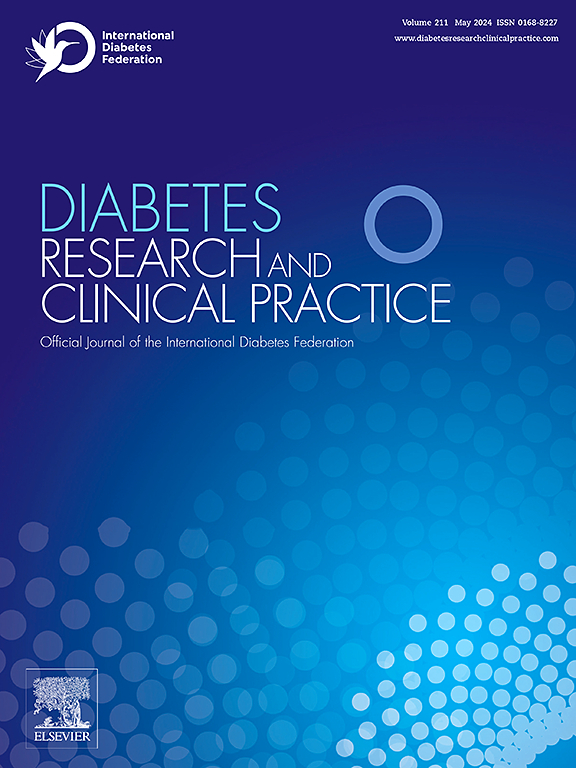替西肽治疗房颤合并2型糖尿病的临床疗效:一项回顾性队列研究
IF 6.1
3区 医学
Q1 ENDOCRINOLOGY & METABOLISM
引用次数: 0
摘要
目的本研究旨在评估替西肽是否与2型糖尿病(T2D)患者心房颤动(AF)负担的减轻有关。方法采用TriNetX数据库进行回顾性队列研究。研究对象包括在2022年1月至2025年2月期间诊断为房颤和T2D的成年人。主要终点是复律、静脉使用抗心律失常药物和房颤消融的综合结果。次要结局包括组合的每个组成部分,心力衰竭,缺血性中风和全因死亡率。采用倾向评分匹配和Cox模型。根据房颤类型、冠状动脉疾病、慢性肾脏疾病、心力衰竭和肥胖进行亚组分析。结果匹配后,分析了11194例患者。替西帕肽的使用与主要结局的风险显著降低相关(HR: 0.65;95% ci: 0.55-0.76;P & lt;0.001)。在所有次要结局中也观察到显著的发现,包括心律转复、静脉抗心律失常治疗、心房颤动消融、心力衰竭、缺血性中风和全因死亡率。这些关联在预先指定的亚组和多重敏感性分析中保持一致。结论替西帕肽可显著降低T2D和AF患者的房颤负担。这些发现提示替西帕肽具有潜在的治疗作用,支持进一步的前瞻性评价。替泽肽是一种双GLP-1/GIP受体激动剂,已显示出代谢和心血管益处,但其对心房颤动负担的影响尚不清楚。使用TriNetX数据库,该研究分析了11194例房颤和T2D患者,发现使用替西帕肽与较低的2年转复风险、静脉使用抗心律失常药物和房颤消融(HR: 0.65;95% ci: 0.55-0.76;P & lt;0.001)。这些发现表明替西帕肽可能对这一高危人群有治疗效果,值得通过随机临床试验进一步研究。本文章由计算机程序翻译,如有差异,请以英文原文为准。
Clinical effectiveness of tirzepatide for patients with atrial fibrillation and type 2 diabetes: A retrospective cohort study
Aim
This study aimed to evaluate whether tirzepatide is associated with a reduced atrial fibrillation (AF) burden in patients with type 2 diabetes (T2D).
Methods
A retrospective cohort study was conducted using the TriNetX database. Adults with both AF and T2D diagnosed between January 2022 and February 2025 were included. The primary outcome was a composite of cardioversion, intravenous antiarrhythmic drug use, and AF ablation. Secondary outcomes included each component of the composite, heart failure, ischemic stroke, and all-cause mortality. Propensity score matching and Cox models were used. Subgroup analyses were conducted based on AF type, coronary artery disease, chronic kidney disease, heart failure, and obesity.
Results
After matching, 11,194 patients were analyzed. Tirzepatide use was associated with a significantly lower risk of the primary outcome (HR: 0.65; 95 % CI: 0.55–0.76; P < 0.001). Significant findings were also observed across all secondary outcomes, including cardioversion, intravenous antiarrhythmic therapy, atrial fibrillation ablation, heart failure, ischemic stroke, and all-cause mortality. These associations remained consistent across prespecified subgroups and multiple sensitivity analyses.
Conclusion
Tirzepatide was significantly associated with reduced AF burden in patients with T2D and AF. These findings suggest a potential therapeutic role, supporting further prospective evaluation.
Condensed abstract
Tirzepatide, a dual GLP-1/GIP receptor agonist, has shown metabolic and cardiovascular benefits, but its impact on AF burden remains unclear. Using the TriNetX database, this study analyzed 11,194 patients with AF and T2D and found that tirzepatide use was significantly associated with a lower two-year risk of cardioversion, intravenous antiarrhythmic drug use, and AF ablation (HR: 0.65; 95 % CI: 0.55–0.76; P < 0.001). These findings suggest that tirzepatide may offer therapeutic benefits in this high-risk population, warranting further investigation through randomized clinical trials.
求助全文
通过发布文献求助,成功后即可免费获取论文全文。
去求助
来源期刊

Diabetes research and clinical practice
医学-内分泌学与代谢
CiteScore
10.30
自引率
3.90%
发文量
862
审稿时长
32 days
期刊介绍:
Diabetes Research and Clinical Practice is an international journal for health-care providers and clinically oriented researchers that publishes high-quality original research articles and expert reviews in diabetes and related areas. The role of the journal is to provide a venue for dissemination of knowledge and discussion of topics related to diabetes clinical research and patient care. Topics of focus include translational science, genetics, immunology, nutrition, psychosocial research, epidemiology, prevention, socio-economic research, complications, new treatments, technologies and therapy.
 求助内容:
求助内容: 应助结果提醒方式:
应助结果提醒方式:


